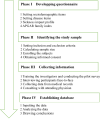Family functioning and health-related quality of life of inpatients with coronary heart disease: a cross-sectional study in Lanzhou city, China
- PMID: 36068504
- PMCID: PMC9446873
- DOI: 10.1186/s12872-022-02844-x
Family functioning and health-related quality of life of inpatients with coronary heart disease: a cross-sectional study in Lanzhou city, China
Abstract
Background: A key outcome in coronary heart disease (CHD) is Health Related Quality of Life (HRQoL), and family functioning is important in the management of CHD. But few studies have examined both together, and little is known about them among inpatients with CHD in less developed areas of China. Therefore, this study aimed to assess the HRQoL and family functioning status of inpatients with CHD in Lanzhou from Northwest China, and identify the factors that affect their HRQoL.
Methods: A cross‑sectional study was conducted in 224 CHD inpatients at one major hospital. Sociodemographic data and disease information of CHD inpatients were collected by face-to-face using a structured questionnaire and data were also obtained from patient medical records. HRQoL was measured using the Sickness Impact Profile (SIP). Family functioning was measured using the family APGAR index. Multiple binary logistic regression analysis (MBLRA) was used to explore potential risk factors associated with HRQoL, and Pearson's correlations were used to assess the relationship between family functioning and HRQoL.
Results: The overall, physical and psychosocial SIP scores were 25.03 ± 8.52, 18.61 ± 9.90 and 28.08 ± 9.64, respectively. The total family APGAR score was 6.11 ± 2.45. MBLRA found older age, poorer cardiac function and more severe disease were associated with poorer HRQoL, while better family functioning, higher monthly income, and urban living were associated with better HRQoL. Family functioning was weakly to moderately correlated with total and psychosocial HRQoL.
Conclusions: Older and less affluent inpatients with lower educational level, less family support and more severe CHD have poorest quality of life, and health care providers should consider interventions to support them.
Keywords: Coronary heart disease; Family APGAR index; Family functioning; Health-related quality of life; Northwest China; Sickness impact profile.
© 2022. The Author(s).
Conflict of interest statement
The authors declare that they have no competing interests.
References
-
- Timmis A, Townsend N, Gale CP, Torbica A, Lettino M, Petersen SE, et al. European Society of Cardiology: Cardiovascular Disease Statistics 2019. Eur Heart J Qual Care Clin Outcomes. 2020;6(1):7–9. - PubMed
-
- The Writing Committee of the Report on Cardiovascular Health and Diseases in China. Interpretation of Report on Cardiovascular Health and Diseases in China 2020 (in Chinese). Chin J Cardiovasc Med.2021, 26(3):209–18.
-
- Yu Q, Shao H, He P, Duan Z. World scientific collaboration in coronary heart disease research. Int J Cardiol. 2013;167(3):631–639. - PubMed
Publication types
MeSH terms
LinkOut - more resources
Full Text Sources
Miscellaneous


